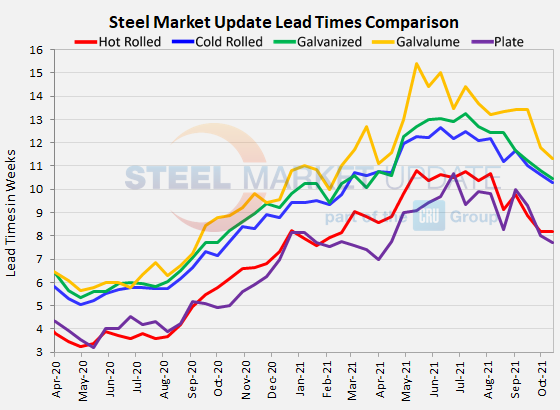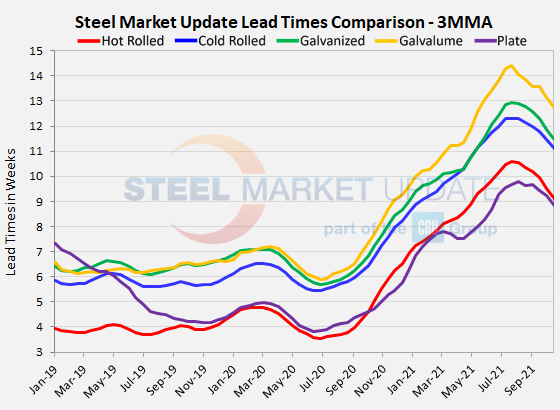SMU Data and Models

Steel Mill Lead Times: Falling Along With Prices
Written by Tim Triplett
October 14, 2021
Mill lead times for orders of flat rolled and plate products have shortened significantly over the past month. Steel Market Update’s latest check of the market shows the average lead times for hot rolled, cold rolled and galvanized steel have come in by roughly three-fourths of a week. The typical hot rolled lead time is down to nearly eight weeks, while cold rolled and galvanized are now closer to 10 than 11 weeks. Plate lead times have shrunk to less than eight weeks.
Buyers polled by SMU this week reported mill lead times ranging from 5-11 weeks for hot rolled, 8-12 weeks for cold rolled, 6-14 weeks for galvanized, 9-13 weeks for Galvalume, and 6-10 weeks for plate.
The average lead time for spot orders of hot rolled has declined to 8.19 weeks, down from 8.89 weeks one month ago. Cold rolled lead times moved down to 10.30 weeks from 11.00. Galvanized lead times dipped to 10.48 weeks from 11.22 weeks in mid-September. The average Galvalume lead time dropped by a full two weeks to 11.33 from 13.43 weeks in the same period.
Like sheet products, mill lead times for plate have also shortened. The average plate lead time moved down to 7.71 weeks from the 9.30 weeks seen in SMU’s check of the market a month ago.
Lead times are considered a leading indicator of steel prices. The shorter the lead times, the less busy the mills and the more likely they are to negotiate on price to secure orders. Shorter lead times are consistent with the declining steel prices seen over the past few weeks.


By Tim Triplett, Tim@SteelMarketUpdate.com

Tim Triplett
Read more from Tim TriplettLatest in SMU Data and Models

SMU Scrap Survey: Sentiment Indices rise
Both current and future scrap sentiment jumped this month, though survey participants reported responses before key trade news was announced.

SMU Survey: Sentiment splits, buyers have better view of future than the present
SMU’s Steel Buyers’ Sentiment Indices moved in opposite directions this week. After rebounding from a near five-year low in late June, Current Sentiment slipped again. At the same time, Future Sentiment climbed to a four-month high. Both indices continue to show optimism among buyers about their company’s chances for success, but suggest there is less confidence in that optimism than earlier in the year.

SMU scrap market survey results now available
SMU’s ferrous scrap market survey results are now available on our website to all premium members. After logging in at steelmarketupdate.com, visit the pricing and analysis tab and look under the “survey results” section for “ferrous scrap survey” results. Past scrap survey results are also available under that selection. If you need help accessing the survey results […]

SMU flat-rolled market survey results now available
SMU’s latest steel buyers market survey results are now available on our website to all premium members. After logging in at steelmarketupdate.com, visit the pricing and analysis tab and look under the “survey results” section for “latest survey results.” Past survey results are also available under that selection. If you need help accessing the survey results, or if […]

SMU Survey: Sheet lead times stabilize, plate contracts
Mill lead times for sheet products were steady to slightly longer this week compared to our late June market check, while plate lead times contracted, according to steel buyers responding to this week’s market survey.
